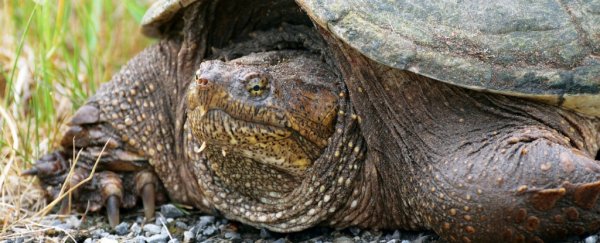During winter time, some snapping turtles like to hibernate in ponds and lakes. Safely tucked away underneath a thin layer of ice, these freshwater reptiles can survive up to six months without any oxygen to speak of.
How their bodies can cope with this depends on the way they were raised, it turns out. New research has revealed that when turtle embryos are exposed to low levels of oxygen, it programs their hearts to be more resilient to such conditions for the rest of their lives.
From the very start of their existence, it appears these incredible creatures are primed for a life of aquatic hypoxia. Developing in nests deep beneath the water, their embryos can sometimes be subject to as little as 11 percent oxygen, and this can permanently alter their cardiac structure and function.
"We're excited to be the first to show that it is possible to change the degree of tolerance that turtles have for low oxygen environments by early exposure to hypoxia during development," says cardiac biologist Ilan Ruhr from the University of Manchester.

Survival in hypoxic conditions depends on the ability of the heart to continue delivering nutrients and removing waste. When humans suffer from heart attacks, their hearts are usually damaged by the resulting hypoxia, and the same thing can happen during heart transplants.
Yet reptiles like turtles and alligators can withstand these extreme environments and still maintain their metabolism and muscle function. To figure out what was happening on a cellular level, the researchers studied a group of juvenile Common Snapping Turtles (Chelydra serpentina), half of which developed under normal oxygen conditions of 21 percent, and half of which developed under oxygen levels of just 10 percent.
Isolating muscle cells from the heart, the cells were then subjected to lower levels of oxygen, allowing the team to measure changes in pH, intracellular calcium (which helps contract the heart muscles), and chemicals called reactive oxygen species (ROS).
Even when oxygen was reintroduced, something that causes extensive tissue damage in mammals, the heart cells showed little apparent injury.
The findings suggest that developmental oxygen is an important environmental cue for turning on and off certain genes, which allow the turtle's heart to tolerate zero oxygen.
The early exposure not only reduces the amount of ROS, a molecule that can become toxic when tissue reoxygenates too quickly, but it can also protect their heart muscles from damage, allowing them to contract normally even in the complete absence of oxygen.
"Collectively, these results suggest developmental hypoxia alters pathways involved in ROS management that might protect the heart against oxidative stress," the authors conclude.
One day, the researchers hope this knowledge can be used to keep the human heart alive and well under hypoxic conditions. For instance, in the future a drug may be able to switch on the same mechanisms and protect the human heart from oxygen deprivation.
"Heart cells in turtles and humans are anatomically quite similar," explains comparative physiologist Gina Galli from The University of Manchester, "so if we can learn to understand what factors allow them to survive in an oxygen-free environment, we'd hope to be able to apply that to a medical scenario."
The research was published in Proceedings of the Royal Society B.
